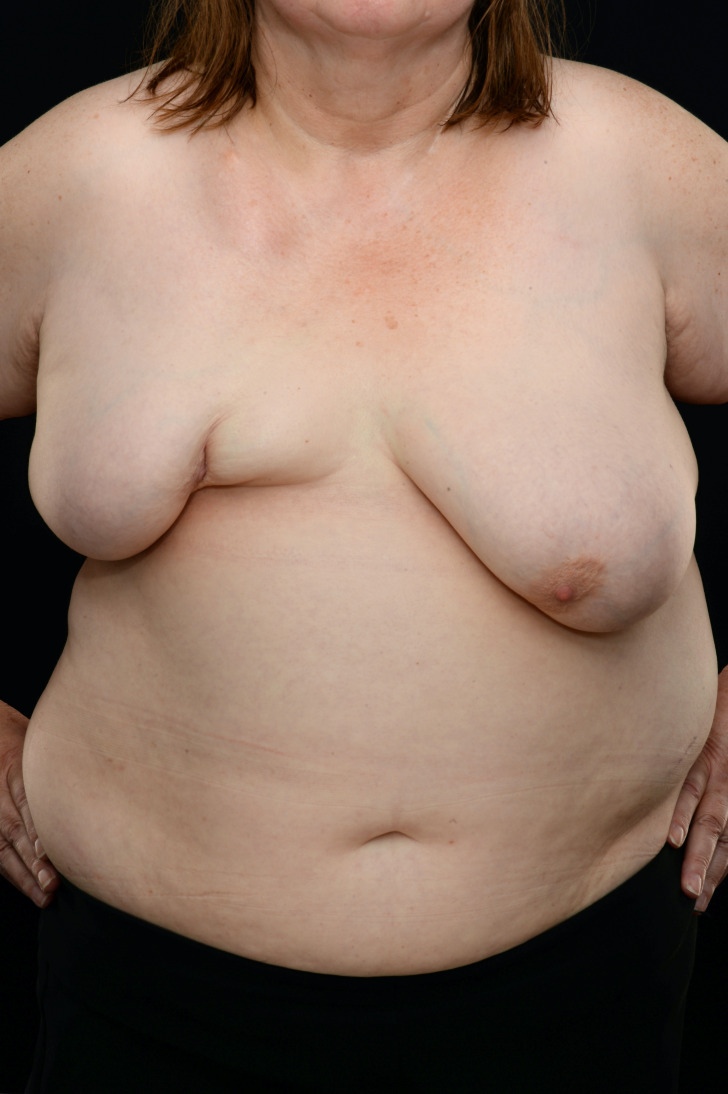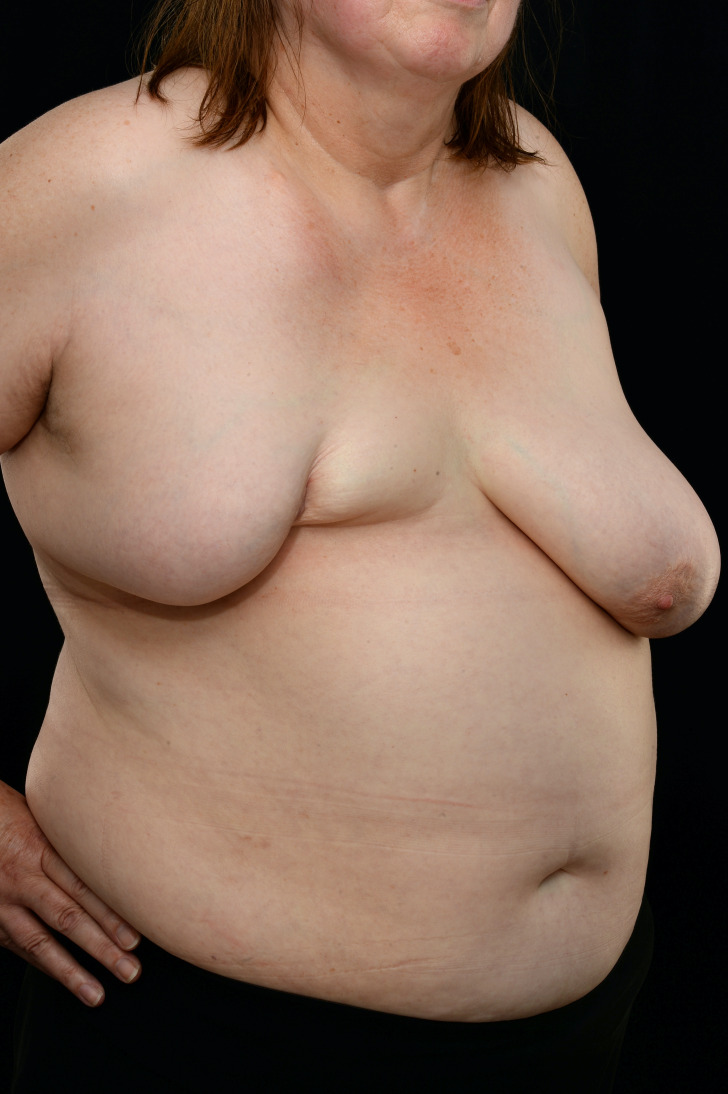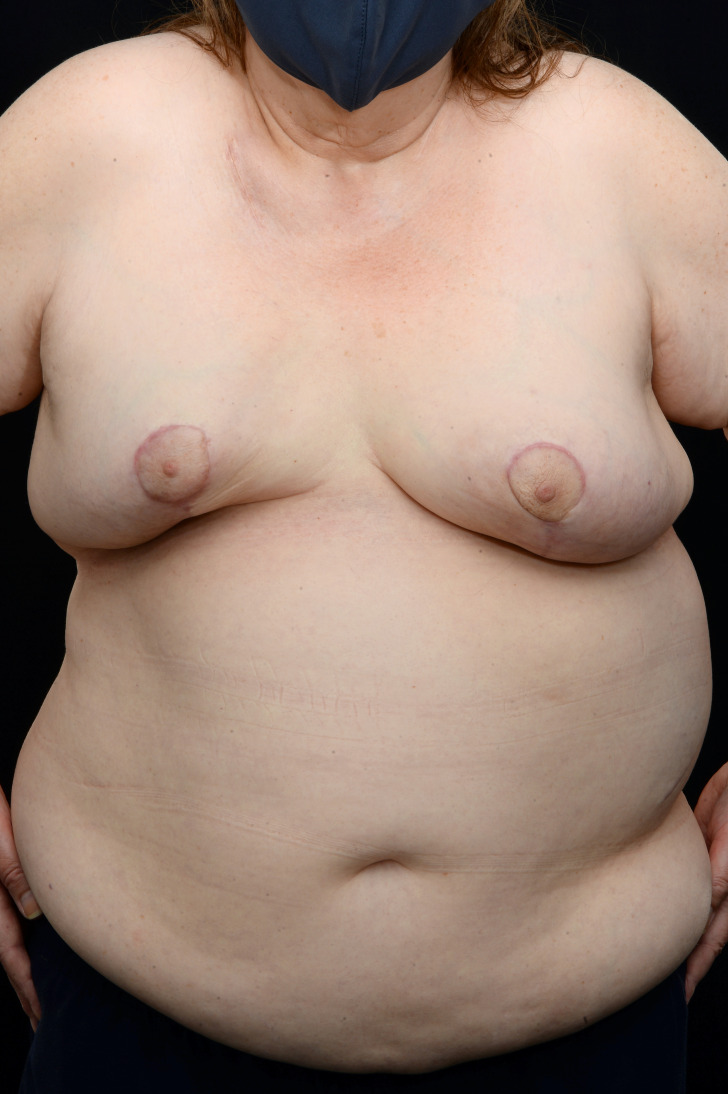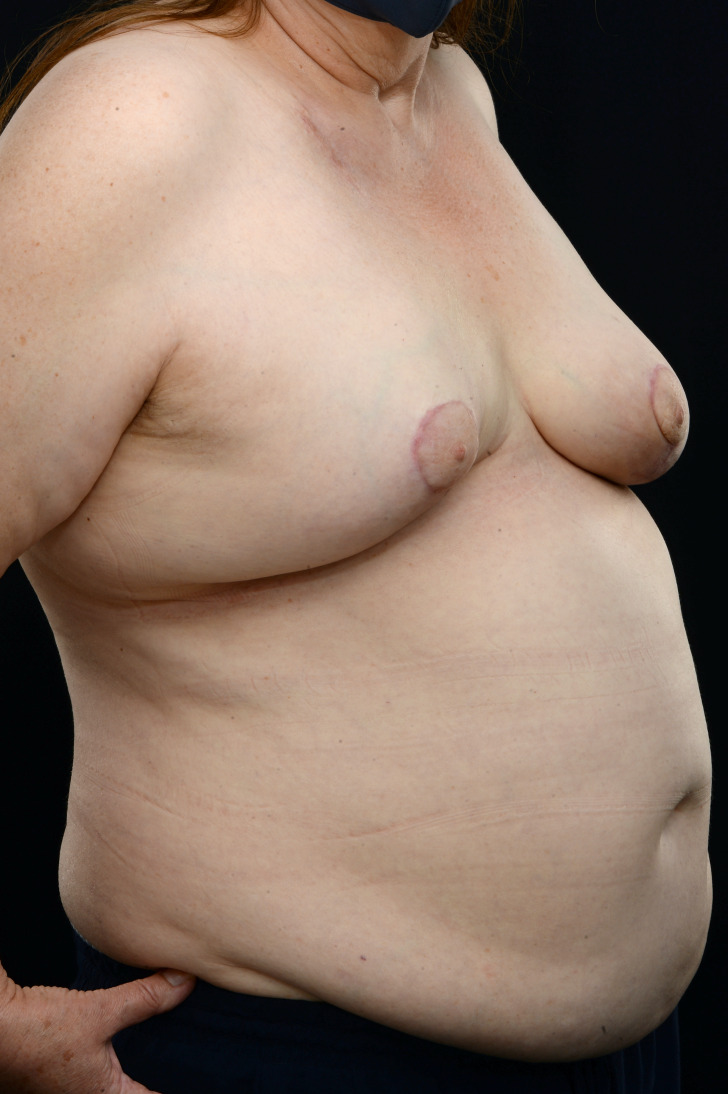Abstract
Seat belt breast deformity can result in significant aesthetic, functional and psychosocial sequelae. Although seat belt breast deformity is well documented, there is a lack of literature describing their reconstructive management. We describe the surgical management of a 63-year-old woman presenting with stage 2b seat belt breast deformity, who underwent scar revision, repositioning of the nipple–areola complex and contralateral breast reduction using Wise-pattern incisions based on superior pedicles. She made an excellent recovery with an improved aesthetic result.
Keywords: breast surgery, plastic and reconstructive surgery, trauma
Background
The WHO estimates there are 1.35 million deaths per year from road traffic accidents. In the UK, in 2019 there were 89 331 casualties and 736 fatalities from car-related road traffic incidents.1 2 The introduction of seat belt legislation in February 1983 has led to a marked reduction in road traffic accident-related mortality. However, it has also led to an increase in a specific pattern of blunt trauma known as ‘seat belt syndrome’.3 The exact incidence of seat belt trauma is unknown and often under-reported. Seat belt syndrome injuries range from soft tissue injury of the torso, sternal fractures, spinal injuries and perforation of abdominal viscera. To date, a total of 47 patients with seat belt-related breast trauma have been described in the literature. These cases cover a wide spectrum of presentations ranging from mild injuries to severe and life-threatening injuries.
Soft tissue trauma from seat belt syndrome results from rapid decelerating and compressive shearing forces applied to the torso. A range of factors can influence the degree of soft tissue injury including speed of travel, air-bag deployment, body habitus, and the speed of deceleration.
Seat belt breast deformity occurs when powerful decelerating forces thrust the torso against a rigid overlying seat belt. This can result in significant deformity where the breast soft tissues are split along the oblique axis of the seat belt. It can also result in functional sequelae where the lactiferous ducts are transected.4 Seat belt breast injuries have been predominantly described in women however there are reported cases affecting men.5
Case presentation
A 63-year-old woman presented with a right bisected stage 2b breast deformity. She was a front seat passenger in a head-on road traffic accident in 2013. At the time of collision, she was wearing a three-point lap-diagonal seat belt. She subsequently sustained a closed blunt trauma seat belt injury to her right breast. There were no open wounds at the time of injury, only local swelling and extensive bruising. Eight days post injury she developed sharp, stinging pains in her right breast that lasted approximately 2 weeks. Over the course of the following few months she developed volume shift in the lateral cranial area and into the right axilla with severe indentation and inner scarring. A deep vertical cleft formed through the right breast meridian resulting in bisection of the breast tissue and near total inversion of the right nipple–areola complex (NAC). Breast asymmetry was magnified by a large pendulous contralateral left breast (figures 1 and 2).
Figure 1.
Right-sided breast deformity showing a deep vertical cleft and near total nipple–areola complex inversion (front view).
Figure 2.
Right-sided breast deformity showing a deep vertical cleft and near total nipple–areola complex inversion (lateral view).
In addition to her breast injury she sustained left hand fractures requiring open reduction internal fixation and a traumatic abdominal hernia, repaired 3 years later via a laparoscopic approach.
The resulting breast deformity had led to a significant impact on the patients’ quality of life. Following consultation with her general practitioner she was referred for assessment under the plastic surgery team with a view to performing reconstruction.
Investigations
Clinical photographs were taken preoperatively and postoperatively.
Annual mammographic screening following trauma has not identified any concerning features of malignancy.
Treatment
In 2020, almost 7 years postinjury she underwent scar revision, repositioning of the right NAC, contralateral left breast superior pedicle breast reduction and excision of lipoma in the right upper chest.
Under general anaesthetic, standard Wise pattern breast reduction incisions were made with superior pedicles planned on both sides. Intraoperative findings revealed extensive scarring along the medial aspect of the right breast with tethering of the NAC to underlying soft tissue. The scarring was released, and the NAC was repositioned on its superior pedicle. Bright red bleeding from the edges of the NAC was observed following completion of the scar release.
Simultaneous left breast reduction was performed to achieve symmetry and a well-encapsulated lipoma was removed via a longitudinal excision over the right upper chest (figures 3 and 4).
Figure 3.
Postoperative appearance of the reconstructed right breast (front view).
Figure 4.
Postoperative appearance of the reconstructed right breast (lateral view).
Outcome and follow-up
She made an excellent postoperative recovery with no immediate or late complications. She was discharged from hospital on the same day of surgery with instruction to wear a sports bra for 6 weeks.
At review in clinic 3 months postoperatively she reported no pain or issues with her breasts. She was subsequently discharged from clinic with no further follow-up.
Discussion
In 2007 Majeski classified breast injuries from seat belt blunt trauma. Injuries were broadly categorised 1–4 from mild to severe. Where class 1 included small breast lumps following trauma and class 4 involved breast avulsion injury.6 In 2014 Song et al updated this classification to a four-tier system based on timing of presentation (early or late), presence of bruising, presence of an expanding swelling and presence of a cleft deformity.7 table 1
Table 1.
Severity, investigation and management of seat belt breast injury (modified from Teo and Song classification)7
| Severity | Presentation | Investigations | Management |
| Stage 1a | Immediate with bruising and pain | Chest X-ray ± USS, trauma assessment | Dress/close wounds Capsulotomy ± implant exchange |
| Stage1b | Immediate with expanding breast | CT scan ± contrast angiogram, trauma assessment | Resuscitation, consider arterial embolisation ± blood transfusion |
| Stage 2a | Late with tender or palpable lump | Triple assessment | Consider reconstruction with lump excision Breast cancer surveillance |
| Stage 2b | Late with structural change | MRI + triple assessment | Consider reconstruction, scar revision ± NAC repositioning ± contralateral breast reduction. Breast cancer surveillance |
NAC, nipple–areola complex; USS, Ultrasound.
A late presentation, defined as more than 3 weeks postinjury, with a cleft deformity typically provides a more complex reconstructive challenge. These injuries are also associated with a higher rate of breast cancer following triple assessment (17.2%).
For this reason, it is currently recommended that all patients with 2b or significant seat belt breast deformity should receive close monitoring for developing breast cancer. Monitoring should be with annual mammography and triple assessment if a new mass is identified.7
Stage 2b breast deformity provides a significant reconstructive challenge in restoring natural breast contour, repositioning of the NAC and restoration of the infra-mammary fold.
A modified Hall-Findlay type mastopexy has been described by Paddle et al with good aesthetic results when managing a bisected stage 2b breast deformity.8 Teo et al described a similar approach whereby the edges of indentation were incised and de-epithelised. The NAC was subsequently raised on a superolateral pedicle while superomedial and inferolateral pillars were created and mobilised to close the defect.9
Due to the wide range in presentation of blunt breast deformity, there is no current adopted standard of reconstruction. Cases should be assessed on an individual basis where realistic targets are set, taking into account the degree of deformity, patient expectation, surgical expertise and patient factors including comorbidities and body habitus (Table 2).
Table 2.
Complications of seat belt breast injuries and associated investigation and management5–8
| Complications | Investigations | Management |
| Expanding haematoma | Contrast CT angiogram | Resuscitation ± blood transfusion Consider urgent embolisation ± surgical haemostasis |
| Lactiferous duct injury | Ultrasound ± MRI | Aspiration±drain insertion ± medication to suppress lactation |
| Fat necrosis | Clinical assessment | Conservative ± excision |
| Breast lump | Triple assessment | Consider excision ± reconstruction |
| Implant rupture | Ultrasound ± MRI | Capsulotomy ± implant removal or exchange |
| Pectoralis major rupture | Ultrasound ± MRI | Consider surgical tendon repair and physiotherapy |
| Morel-Lavallée lesion | Ultrasound ± MRI | Drainage ± capsule debridement and resection |
Learning points.
Severe seat belt breast deformity has a high association with breast malignancy.
Close monitoring with annual mammographic screening is advised for seat belt breast deformity.
Severe bisected breast deformity can be reconstructed via scar release and nipple–areola complex repositioning.
Reconstruction of seat belt breast deformity is associated with improved quality of life.
Footnotes
Contributors: GL collected information and wrote the manuscript. SM, GK and RH edited the manuscript and provided expert advice.
Funding: The authors have not declared a specific grant for this research from any funding agency in the public, commercial or not-for-profit sectors.
Competing interests: None declared.
Provenance and peer review: Not commissioned; externally peer reviewed.
Ethics statements
Patient consent for publication
Obtained.
References
- 1.World Health Organisation (WHO) . Road traffic injuries. Available: https://www.who.int/news-room/fact-sheets/detail/road-traffic-injuries [Accessed May 2021].
- 2.Department for transport, reported road casualties in Great Britain: 2019 annual report. Available: https://assets.publishing.service.gov.uk/government/uploads/system/uploads/attachment_data/file/922717/reported-road-casualties-annual-report-2019.pdf [Accessed May 2021].
- 3.Newman RJ. Chest wall injuries and the seat belt syndrome. Injury 1984;16:110–3. 10.1016/S0020-1383(84)80010-8 [DOI] [PubMed] [Google Scholar]
- 4.Eastwood DS. Subcutaneous rupture of the breast: a seat-belt injury. Br J Surg 1972;59:491–2. 10.1002/bjs.1800590622 [DOI] [PubMed] [Google Scholar]
- 5.Noel OF, Fornadley J, Potochny J. Restoring the severed breast and chest following seat belt trauma. Plast Reconstr Surg Glob Open 2020;8:e2849. 10.1097/GOX.0000000000002849 [DOI] [PMC free article] [PubMed] [Google Scholar]
- 6.Majeski J. Shoulder restraint injury of the female breast. Int Surg 2007;92:99–102. [PubMed] [Google Scholar]
- 7.Song CT, Teo I, Song C. Systematic review of seat-belt trauma to the female breast: a new diagnosis and management classification. J Plast Reconstr Aesthet Surg 2015;68:382–9. 10.1016/j.bjps.2014.12.005 [DOI] [PubMed] [Google Scholar]
- 8.Paddle AM, Morrison WA. Seat belt injury to the female breast: review and discussion of its surgical management. ANZ J Surg 2010;80:71–4. 10.1111/j.1445-2197.2009.05178.x [DOI] [PubMed] [Google Scholar]
- 9.Teo I, Dujon D, Azmy I. Seat belt injury causing bisection of the breast: a case report. J Plast Reconstr Aesthet Surg 2014;67:1008–9. 10.1016/j.bjps.2014.01.024 [DOI] [PubMed] [Google Scholar]






